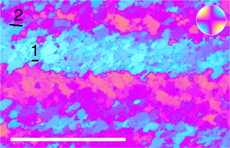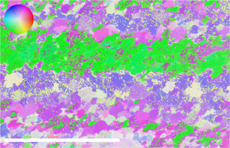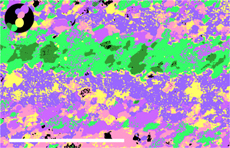5.2
ORIENTATION IMAGES OF NATURALLY DEFORMED ROCKS
top / contents / section 5 / pages -- 5.1 -- 5.2 -- 5.3 -- 5.4 -- 5.5 -- 5.6
Quartz mylonite from the Corvatsch
(Christian Pauli)

The quartz sample discussed here is taken from a quartz vein of the Corvatsch mylonite. The Corvatsch mylonite zone is located in SE Switzerland and represents an extensional fault zone that formed during the collapse of the Austroalpine nappes stack, built up in Early Alpine times [19]. The quartz vein is parallel to the fault zone, lineated and about 5 cm thick. It has formed in pre-fault zone times. The mylonitization is contemporaneous with a marked pressure decrease (8->6 kbar) and occurs under temperatures between 350° and 400°C. The strongly domainal nature of the sample, in particular, the herring bone microstructure, could be attributed to a flattening component of the displacement along the fault zone. In this case, the shape of the domains may be taken as finite strain markers. On the other hand the domainal microstructure could be interpreted as a steady state structure, where deformation and recrystallization are partitioned into a heterogeneous pattern.
Reference:
Panozzo Heilbronner, R. and C. Pauli (1994). Orientation and misorientation imaging: integration of microstructural and textural analysis. Textures of geological materials. H. J. Bunge, S. Sieg esmund, W. Skrotzki and K. Weber. Oberursel, DGM Informationsgesellschaft Verlag: 147-164.
Pauli, C., PhD thesis, Dept. of Geosciences, Basel University (http://www.unibas.ch/earth/)
Left, from top to bottom:
(a) image of thin section as it appears under crossed polarizers and lamba plate. Inset shows conoscopic image of quartz. Scale bar is 1mm. 1,2 = traverses of misorientation profiles (not shown here.
(b) Profile 1 crossing grain boundaries at pixel No. 10, 30 and around 47. Profile 2 lies within one grain.
(c) CIP calculated orientation image using standard CLUT.
(d) CIP calculated orientation image using problem oriented, blobby CLUT that enhances the domainal nature of this mylonite.



